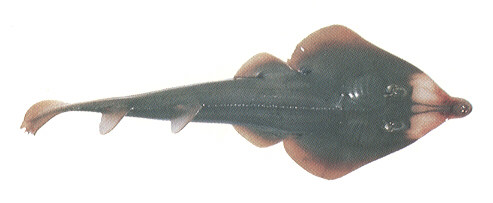Shovelnose Guitarfish
Common Name: Shovelnose Guitarfish
Scientific Name: Rhinobatos productus

Description
The body of the shovelnose guitarfish is depressed and gradually tapers into the tail; the disk is longer than wide. The snout is rather long and rounded at the tip. The color is gray above becoming lighter below. This species is distinguished from the banded guitarfish by the absence of dark crossbars on the back. It can be separated from most others of this flattened and plated group by the presence of a tail fin and two dorsal fins. Its sharp pointed nose distinguishes it from the other guitarfishes.
Range
Gulf of California to San Francisco, California. The shovelnose can be found, sometimes in large numbers, over sand or mud sand bottoms in colder, shallow coastal waters.
Natural History
The guitarfish diet consists of a variety of crustaceans, worms and clams. They have been observed feeding on sand crabs in water less than 3 inches deep. At times they are left stranded on the beach by receding waves and must wiggle their way back into the water much like grunion. Shovelnose guitarfish bear live young, with as many as 28 from a single female. Mating takes place during the summer months and the young, apparently born during the following spring and summer, are 6 inch miniatures of the adults.
Fishing Information
Shovelnose guitarfish are caught in the surf, in bays and from piers. They take live or dead bait including clams, mussels, sand crabs and almost any other bait or lure. The flesh, especially the tail and back straps, is considered quite good.
Other Common Names
shovelnose shark, pointed nosed guitarfish, guitarfish
Largest Recorded
5 feet 1.5 inches; 40.5 pounds.
Habitat
Shallow Sandy Environment.
 Deep Sea Crabs
Deep Sea Crabs